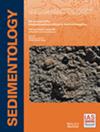Logratio analysis of components separated from grain-size distributions and implications for sedimentary processes: An example of bottom surface sediments in a shallow lake
IF 2.8
2区 地球科学
Q1 GEOLOGY
引用次数: 0
Abstract
The grain-size distributions of sediments can yield important information about sediment provenance and sedimentary processes; however, grain-size distributions are frequently polymodal, rendering analyses difficult. To improve analyses of polymodal grain-size data, the present study decomposed the grain-size distributions of bottom surface sediments from Lake Kitaura, a shallow lake in Japan, into lognormal distributions and performed logratio analysis of their mixing proportions. The polymodal grain-size distributions of the studied samples were separated into four common components at most sites. This logratio analysis revealed clear differences in the characteristics of the spatial distributions of the separated grain-size components. The logratio values indicated that the three finer components were uniformly deposited within the lake, whereas the coarsest component was spatially diverse, reflecting differences in their sources and sedimentary processes. These results demonstrate the effectiveness of decomposition and logratio analysis of polymodal grain-size distributions for estimating sedimentary processes. This method can be applied to modern sediments and for palaeoenvironmental reconstructions using sediment cores.从粒度分布中分离出的成分的对数比率分析及其对沉积过程的影响:以浅水湖底表层沉积物为例
沉积物的粒度分布可以提供有关沉积物来源和沉积过程的重要信息;然而,粒度分布经常是多模态的,给分析带来了困难。为了改进多模态粒度数据的分析,本研究将日本浅湖北浦湖底表层沉积物的粒度分布分解为对数正态分布,并对其混合比例进行了对数比率分析。所研究样本的多模态粒度分布在大多数地点被分为四个共同成分。这种对数比率分析表明,被分离的粒度成分的空间分布特征存在明显差异。对比率值表明,三个较细的成分在湖泊内均匀沉积,而最粗的成分在空间上具有多样性,反映了它们的来源和沉积过程的差异。这些结果表明,对多模态粒度分布进行分解和对数比率分析可有效估算沉积过程。这种方法可应用于现代沉积物以及利用沉积岩芯进行古环境重建。
本文章由计算机程序翻译,如有差异,请以英文原文为准。
求助全文
约1分钟内获得全文
求助全文
来源期刊

Sedimentology
地学-地质学
CiteScore
8.20
自引率
11.40%
发文量
94
审稿时长
6-12 weeks
期刊介绍:
The international leader in its field, Sedimentology publishes ground-breaking research from across the spectrum of sedimentology, sedimentary geology and sedimentary geochemistry.
Areas covered include: experimental and theoretical grain transport; sediment fluxes; modern and ancient sedimentary environments; sequence stratigraphy sediment-organism interaction; palaeosoils; diagenesis; stable isotope geochemistry; environmental sedimentology
 求助内容:
求助内容: 应助结果提醒方式:
应助结果提醒方式:


